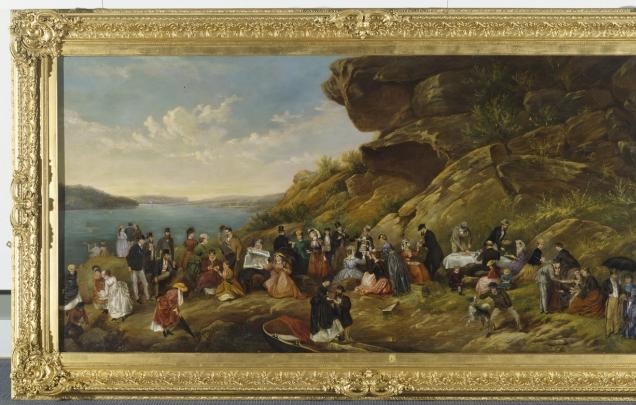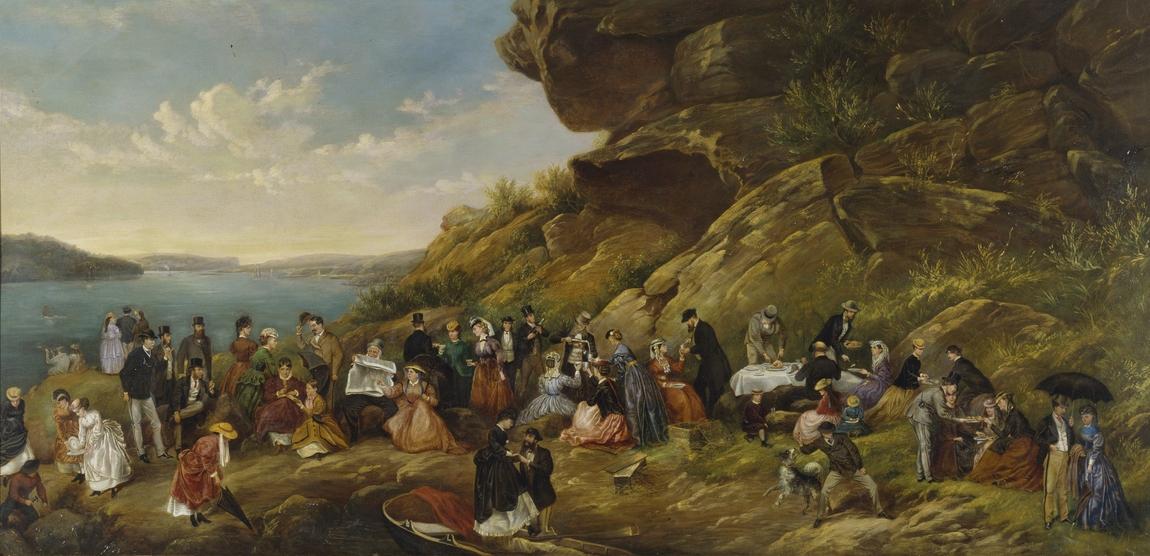Bringing the painting to life
This is the student activity 1 of 2 of the A day's picnic at Clark Island learning activity.

Key inquiry question #1
A Day’s Picnic at Clark Island, 1870, Eugene Montagu Scott, oil painting
Annotating activity

Look carefully at the painting and make a list of all the activities you see in the painting.
You can either annotate a printed copy of the image with captions (by gluing an A4 print out of the painting into the middle of an A3 sheet of paper and drawing lines from your captions to the appropriate scenes) or digitally annotate the painting on a smart board or device.
What are they thinking and saying?
Further your annotation of the painting by including speech and thought bubbles that contain your imaginings of what individuals in the painting may be thinking or saying.
Create your script
This painting resembles a tableau or a frozen moment from a dramatic presentation or play. It also resembles a still frame from a film.
A good play features action and conflict, and there are plenty of moments of action and conflict in this painting. For example: A mother disapproves of her daughters flirting with a young man, whilst the father, perhaps wanting to marry them off, hides behind his newspaper and ignores their behaviour.
Activity
In small groups, write the script for a short dramatic scene (1-2 minutes in length) that depicts an aspect of the picnic on Clark Island. Your scene should be based on a group of individuals from the painting, who will be the characters in your script. You should ensure that each person in your group plays the part of a character from the painting.
Include stage directions, character names, and dialogue in your script (see notes on formatting a stage script, below).
You may wish to include an internal monologue in your script. An internal monologue, spoken out loud, captures the inner thoughts of a character in the form of a stream of consciousness. For example, an internal monologue might be written from the point of view of the woman exploring the rock pools with her umbrella, the servant removing oysters from the rocks or the mother noticing her two daughters are flirting with the gentleman raising his hat.
Be prepared to perform your scene for the class.
Formatting a stage script
There are many approaches to formatting a stage or drama script.
Here are a few simple rules to follow:
- Stage directions are written in italics (He lifts his hat to the two girls and smiles) (smiling)
- Character names are written in capitals followed by a colon (CAROLINE:)
- Dialogue is written in lower case (Good morning, young lady.)
- Make a second line tab so that each line of dialogue starts at the same point on the page
- Dialogue is single spaced within a character’s speech and double spaced between each character’s speech
- Leave a wide margin
- Include page numbers
One of the best ways to understand how to format a drama script is to explore examples of published play scripts.
Putting it together
Present different scenes from each group one after the other to create a dramatic portrait of the picnic day on Clark Island. You might like to begin each of the short scenes with a frozen moment or tableau.
A tableau is a kind of acting snap shot. It creates a scene with body language, facial expressions and perhaps a few well-placed props. The actors begin the scene by freezing or holding the same pose as the characters they play from the painting.
You might also end each scene with a frozen moment to indicate it has concluded.
Option - Building on the tableau
In the performance of the tableau you may wish to invite audience participation.
Ask each performer or group of performers to present their tableau, once it has been presented invite a member of the audience to tap one of the frozen performers on the shoulder. This is the performer’s cue to explain what they are saying, doing or thinking at that moment. The audience member might also tap a prop or costume element and ask for its role or significance to be explained.
This activity can work well if students are asked to represent a key scene or event from a film, poem, narrative, play or digital text they are studying.